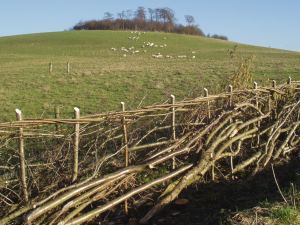Why and how to hedgelay
Hedges are a huge part of the British landscape, creating the patchwork of fields that have become so familiar. There are an estimated half a million miles of hedgerow in the UK, although according to the Woodland Trust this is 118,000 fewer miles than there were in the 1950s. Despite this decline, hedges remain a significant part of our nation’s farming heritage and have long-term environmental benefits, supporting biodiverse habitats and soaking up carbon.
At Earth Trust, most of our hedges are maintained by volunteers who lay them every few years. Although the process might look destructive, their work will allow our hedges to thrive for generations to come.

In this post, volunteer Paul tells us more.
—
By Paul Hartley, Earth Trust volunteer
There have been fields in Britain since the Bronze Age, and there have been hedges for hundreds of years – possibly much longer than that.
Benefits to nature and the environment
Hedges are a hugely important wildlife and environmental resource in the UK. In a 2015 article in British Wildlife, Dr. Rob Wolton identified 2,070 species of plant, animal, lichen and fungus in a 90m stretch of hedge. Hedges also connect habitats, so animals can get from one area to another without crossing open fields, and plants and fungi can slowly spread along hedge lines.
While a hedge is essentially a line of trees, you can’t simply leave the trees to grow. As they get bigger, the most vigorous plants crowd- and shade-out the others, and before long you have a line of trees with gaps between them.
In order to maintain a diverse range of habitats, we want to have hedges at Earth Trust and we want to have a mix of newly laid, maturing and mature hedges. Laying a hedge undoubtedly causes some short-term disruption for some wildlife, and a newly laid hedge provides less habitat than a mature hedge. But taking a longer-term view, laying a hedge is one of the best ways of preserving its biodiversity and the environmental conditions needed by many species.
How to lay a hedge
Hedgelaying is a job which is best done over the winter, when people are not busy planting, weeding and harvesting, and more importantly when birds aren’t nesting. One of the beauties of hedgelaying is that only a few tools are needed. Traditionally a billhook is used to clear away undergrowth around the hedge, cut the stems so you can lay them sideways and trim the upper branches. A mallet (or “bosher”) is used to knock in the stakes. In practice we also use saws and loppers or secateurs to trim the hedge, and in more mature hedges an axe can be useful to cut out thicker limbs and remove dead wood.
One of the most artistic aspects of hedgelaying is binding the tops of the stakes together; it’s a bit like plaiting hair. The binders are usually long, thin hazel branches which twist round each other and the stakes. This creates an elegant and very stable wooden “rope” along the top of a newly laid hedge, which soon disappears among the leaves and branches as the hedge grows.

After a hedge has been laid, we trim it annually for the next three years to promote thick growth along the lower section, and then once every three years. This allows the hedge to flower and fruit, providing food for foraging birds and insects. Depending on the conditions, a laid hedge can then last anything from eight to 50 years, but we usually aim to revisit them every 15 years or so.
Different styles of hedgelaying have evolved in different parts of the country. Our local style is “Midland”, which involves knocking in stakes every 50cm or so to support the stems, and twisting thinner stems along the top of the stakes to bind them together for support. As a hedging system, the Midland style is designed to have crops on one side and animals on the other, although most of our hedges are more decorative rather than functional!
“Hedgelaying is a particularly satisfying activity to be involved with because it brings together lots of different skills, and it produces a long-lasting outcome which you can see thriving in the landscape. It’s also a lot of fun, it gets you out into the fresh air, it’s a great team activity where everyone gets a chance to join in and enjoy working together. And although it might look complicated, actually anyone can do it and have fun.”
Find out more about hedgelaying and courses available from our Farm Step Tenant, Clive Leeke from Hedgecraft.